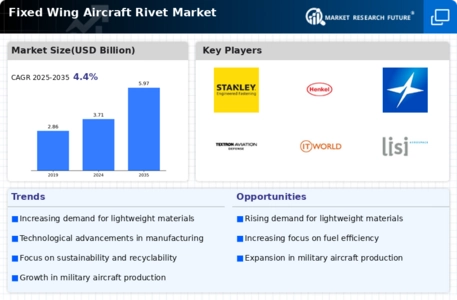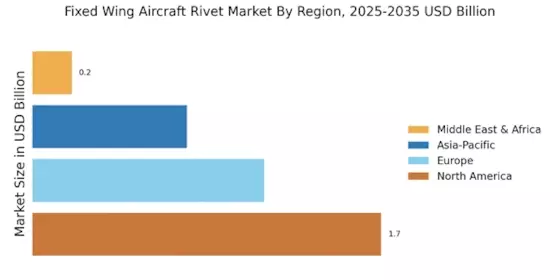Increased Military Spending
The Fixed Wing Aircraft Rivet Market is benefiting from heightened military spending across various nations. Governments are investing significantly in upgrading and expanding their air forces, which necessitates the procurement of new aircraft and the maintenance of existing fleets. This trend is particularly evident in regions where geopolitical tensions are rising, prompting nations to bolster their defense capabilities. As a result, the demand for fixed wing aircraft rivets is expected to increase, driven by the need for robust and reliable fastening solutions in military aircraft. The military aviation sector is projected to grow at a CAGR of around 3.8%, further propelling the Fixed Wing Aircraft Rivet Market.
Rising Aircraft Production Rates
The Fixed Wing Aircraft Rivet Market is experiencing a notable surge in demand due to increasing aircraft production rates. As manufacturers ramp up production to meet the growing need for commercial and military aircraft, the requirement for rivets, a critical component in aircraft assembly, escalates. In recent years, the production of commercial aircraft has seen a compound annual growth rate (CAGR) of approximately 4.5%, indicating a robust market environment. This trend is likely to continue as airlines expand their fleets to accommodate rising passenger numbers. Consequently, the Fixed Wing Aircraft Rivet Market is poised for growth, driven by the need for reliable and durable fastening solutions in aircraft manufacturing.
Expansion of Aerospace Supply Chains
The Fixed Wing Aircraft Rivet Market is experiencing growth due to the expansion of aerospace supply chains. As manufacturers seek to optimize production processes and reduce lead times, they are increasingly relying on a diverse network of suppliers for components, including rivets. This trend is fostering collaboration between rivet manufacturers and aircraft producers, leading to innovations in product design and application. Additionally, the globalization of supply chains is enabling manufacturers to source materials more efficiently, potentially lowering costs. As the aerospace industry continues to evolve, the Fixed Wing Aircraft Rivet Market is likely to benefit from these supply chain dynamics, enhancing overall market competitiveness.
Growing Focus on Aircraft Safety Standards
The Fixed Wing Aircraft Rivet Market is increasingly influenced by the growing emphasis on aircraft safety standards. Regulatory bodies are continuously updating safety regulations, which necessitates the use of high-quality rivets that meet stringent safety requirements. This focus on safety is prompting manufacturers to invest in advanced rivet technologies and materials that enhance structural integrity and performance. As safety standards evolve, the demand for specialized rivets that comply with these regulations is likely to rise. Consequently, the Fixed Wing Aircraft Rivet Market is expected to adapt to these changes, ensuring that products meet the highest safety benchmarks.
Technological Innovations in Rivet Manufacturing
Technological advancements in rivet manufacturing processes are significantly influencing the Fixed Wing Aircraft Rivet Market. Innovations such as automated riveting systems and advanced materials are enhancing the efficiency and quality of rivet production. For instance, the introduction of lightweight composite materials in rivet design is expected to improve fuel efficiency in aircraft, aligning with industry trends towards sustainability. Furthermore, the integration of smart manufacturing technologies is streamlining production, reducing costs, and increasing output. As these technologies become more prevalent, they are likely to reshape the landscape of the Fixed Wing Aircraft Rivet Market, fostering a competitive environment that prioritizes innovation.


















Leave a Comment